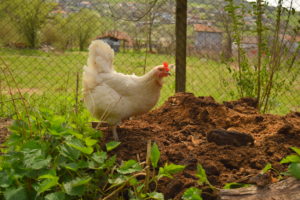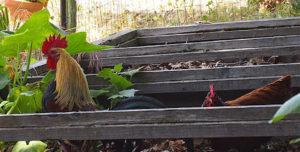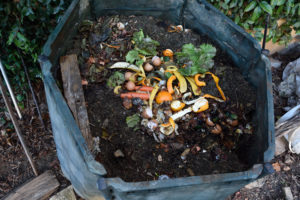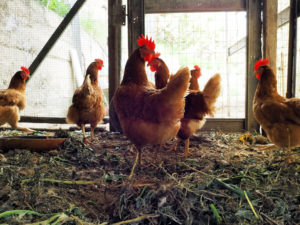
While most backyard chickens exist for the production of eggs and meat, compost is an equally valuable resource the chicken run can provide. Even better, the bulk of the labor is free, and copious amounts of compost pays in dividends. The birds are happier and healthier because there’s no better place to find insects and worms than a compost bin. The diversified diet inspires chickens to produce more eggs, as well as tastier meat. Plus, the rich piles of compost are like organic rocket fuel for the vegetable garden, or “black gold” to sell for profit.
Permaculture
In permaculture, homestead designs are built around closed-loop systems. The home, garden, chicken coop, orchard, and whatever else are designed to work together. These holistic systems require as few outside inputs as possible, and produce little waste. The garden stocks the kitchen, the kitchen scraps go to the compost, the compost feeds the chickens, the chicken manure fertilizes the garden, and the garden stocks the kitchen again. Cycles like this, working towards supplying needs and processing “waste,” will be in action throughout a permaculture site.
Bringing in Your chickens
Incorporating chickens into a composting practice or creating a combined chicken coop/compost bin can save time and energy, as well as make both systems more effective. Chickens are prolific scratchers. They shred up organic material in search of food, and this is exactly what your compost needs. Furthermore, chicken manure has high nitrogen content to add to the compost pile; while the chickens are putting bugs and worms in one end, they’re dropping them out — processed — from the other. Combine this with chicken bedding, and an amazing compost is there for the taking.
Composting Chicken Manure vs Using Chickens to Compost
Backyard chickens are ideal for making compost. The number of birds isn’t so large that the manure is difficult to convert into compost, and the chickens aren’t so many that a compost pile instantly disappears. A small flock will forage in the compost without using it all up and add enough manure to create a nitrogen-rich mix. The chickens will love all of the protein-rich bugs and worms attracted by the compost, and their scratching will help oxygenate the composting materials. Happy chickens and a nicely stirred compost pile!

Composting chicken manure is something entirely different than using chickens to compost, however. Manure is a good source of phosphorus and potassium in addition to other nutrients such as calcium, magnesium, copper, and sulfur, which makes it a more well-rounded and natural fertilizer for gardens than commercial NPK fertilizers. However, too much of good thing can be detrimental. Chicken manure is particularly potent, so high in nitrogen and ammonia that it’s prone to “burn” plants when it hasn’t been thoroughly decomposed. An overabundance of pure chicken manure can pollute waterways, contaminate land, foul the air, and endanger human health.
Coop Bedding
This is where coop bedding comes in. Chicken coops and roosts should have plenty of bedding, usually made from a carbon-rich waste product, such as hay, straw, or wood shavings. When food scraps and nitrogen-rich chicken manure are combined with carbon (as well as oxygen and water), a balanced compost is the result. Left on the ground where it drops, the nitrogen in chicken manure can leach out and become too concentrated of an alkaline. Compost, on the other hand, is almost pH neutral and also contains beneficial bacteria, smells like rich earth, and produces nutrient-rich food for plants.
Cold or Hot Composting and Your Chickens
There are two methods of composting: Cold and Hot. Cold composting isn’t always used with chickens. Some people recommend it, but as the chickens consume so much of the food scraps, you may end up with less compost in the end and your mixture may be higher in chicken manure than is ideal. Hot composting is being recommended here as the better option: the chickens will find lots of yummy treats and stir the compost pile; you will end up with more compost by the end of the month with a good mix of “brown” and “green” material.

Cold Compost
Most of us are familiar with slow-acting, cold-composting methods: creating a gradual mound of kitchen scraps and yard waste. Once a sufficient size, the pile is put to rest, meaning no new materials are added. Even with occasional turning, these piles can take months to mature. These slow cold composts are also notorious for containing seeds that take root once added to the garden, and they’re more likely to harbor pathogens (which perish at the high temperatures typical in hot composting). However, when a cold compost pile is started in your coop, your chickens will eat up a lot of those potentially viable seeds, and add needed nitrogen to the cold compost mix. The main disadvantage to this method is that you have to scoop out the coop to let the composting materials rest and mature.

Hot Compost
With a hot compost pile, you can still use your chickens’ help. Hot piles require more attention but can be ready within a month, as the heat will help plant materials decompose faster. The size — no less than a cubic yard — helps the pile reach high temperatures, which kill pathogens that might be lurking in chicken manure. These same temperatures cook seeds as well, so the compost won’t start sprouting in the garden. And the resulting compost doesn’t reduce nearly as much in size as cold compost piles.
The crux to building a hot compost pile is to put it together all at once. There should be about one part (volume) of “green” material to two parts “brown” material. Green indicates nitrogen-rich items, such as manure, fresh lawn clippings, food scraps, and spent coffee grounds. Brown indicates carbon-rich materials, such as wood shavings, straw, leaves, shredded paper, and cardboard. Green material attracts the microorganisms that heat things up, while carbon keeps it all aerated enough to breathe. Turned regularly, the pile should reach about 150 degrees Fahrenheit in the first week before cooling down and providing dark, rich, fine compost. Chickens will scratch into the hot compost piles, and each week, those piles need to be rebuilt by the humans. This cycle of chicken disassembling and humans reassembling lasts for a month. After that, the resulting rich compost is moved away from the chickens and added to garden beds.
Design Your Coop for Better Composting
Here are three ideas to suit the needs of different sized flocks.
Large Backyard Flocks
If you have a flock of 30 to 40 birds, you might want to think about Geoff Lawton’s composting method of using a chicken tractor, movable compost fencing, and electric netting, which he calls a “chicken tractor on steroids.” It provides a cubic yard of compost every week, and is well-suited to those with big gardens, access to livestock manure, and some additional human help. It begins with a thick layer of bedding beneath a roosting house and in laying boxes. After a week, the now-manured bedding is piled up in a composting cage and additional materials are added, such as cow manure, hay, and vegetable scraps from the farm and nearby restaurants, to make a full cubic yard or more. The chickens are let loose to nibble, scratch, and shred the pile. New bedding is added under the roosts and in the laying boxes.
After a week, the mobile coop (and electric fencing, if you need to keep chickens out of the garden) is moved about 20 feet away, and a new compost pile is started from the next batch of manured bedding. The chickens are now scratching at the newest compost pile, but also at the one from the previous week. At the end of that second week, the first compost pile is raked back up into a mound, the tractor coop is moved another 20 feet, and fresh bedding is added. Each time the coop is moved, the chickens work on new and old piles, stirring them and helping them to process. After the fourth week, the first pile is either moved outside the electric fencing or scooped up and moved away from the reach of the chickens to let it rest and mature.
Medium Backyard Flocks
You can create the same kind of compost system in a stationery set-up with a run that’s about 20 feet long and half as wide. By simply transferring the piles instead of the entire chicken run, the compost is incrementally moved further away from the chicken coop and, ultimately, out of the pen. A certain amount of raking and shoveling needs to happen once a week, but the chickens are still doing most of the composting work.
If you don’t have much human labor available to you, a balanced compost pile can be developed by constructing a bin inside the coop and filling it with bedding, manure, and kitchen scraps over the course of about two weeks. Once the pile is completed, the sides of the bin are removed so the chickens can scratch and spread it. After a week, the pile can be heaped back together, and this process can be repeated for four weeks. Then the compost heap can be turned out of the pen and a new one started inside. This method provides a cubic yard of compost roughly once a month, more than enough to fertilize a sizable family garden, and far less work than maintaining five piles at once.

Small Backyard Flocks
A self-proclaimed “crappy composter,” Erica Strauss of Northwest Edible Life devised an even less laborious method. She covers the floor with a thin layer of sand and then puts a thick layer of bedding down over the sand. Erica tosses daily kitchen scraps onto the bedding, which her chickens scratch, mix, and manure. About twice a year, she harvests the bedding and adds it directly to her gardens. Adding the compost mixture in the fall, after the garden has been put to rest, mulches down the empty beds and helps everything rot and mature over the winter.
Your birds will happily help you compost without even knowing it! You, they, and the broccoli in your garden will benefit from it.
For more information on composting with your chickens, see Use Your Chickens as Compost Workers on the Mother Earth News website.
Jonathon Engels is a traveler, writer, and vegan gardener. Born and raised in Louisiana, he’s lived as an expat for over a decade, worked in nearly a dozen countries, and visited dozens of others in between. His interests include permaculture, cooking, and music. More of his work can be found at Jonathon Engels: A Life About.













3 Comments
Good luck good help
Since chicken manure can burn plants, can it be used for weed control? I’m just wondering if I can put uncomposted chicken manure directly on the garden, then cover it with plastic to get rid of the weeds. I haven’t been able to find anyone who can answer that question for me.
Donna, Yes, you can use un-decomposed chicken manure in this way. You can put the manure on the fall/winter garden bed, cover with leaves and/or straw. Both the manure and the straw will create an anaerobic environment that will help kill weeds and their spring seedlings. In the spring, you can rake everything up and either add it to you compost pile or work it into your garden soil. This is a version of “solarizing”. Here’s a link that may give you more ideas. http://jmgkids.us/solarizingyourgarden/